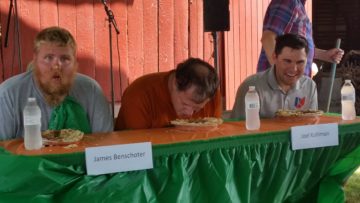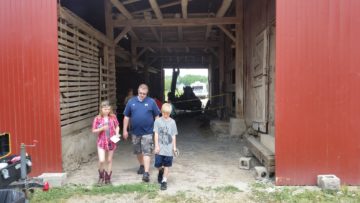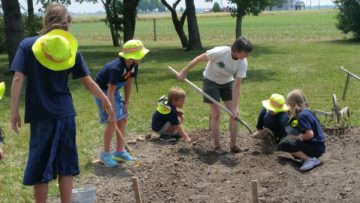By JAN LARSON McLAUGHLIN
BG Independent News
Six grown men tested their stamina and their stomachs Saturday during a no-hands pie eating contest at the Heritage Farm Festival held at the Wood County Park District’s Carter Historic Farm.
James Benschoter put his beard in a ponytail. Dylan Thomason starved himself ahead of time. And Joel Kuhlman thought he was prepared.
“I was actually looking forward to it all week – until I got here,” said Kuhlman, a Wood County commissioner.
The rules were simple, but strict. No utensils. No hands. The first person to finish and stand up won $20.
“The rest of you get to finish the pie we gave you,” said Bryan Bockbrader, the park district’s stewardship coordinator.
“If you pass out in your chair, you are disqualified,” he added.
The men were thanked for sacrificing their dignity, then told to begin.

James Benschoter, Chris Henschen and Joel Kuhlman dig into apple pies.
The apple pies went down easy to start, with the men occasionally lifting their heads to breathe. All the contestants were given large bandana handkerchiefs to use as bibs. But most were employed to get apple pie out of their noses.
As they labored to inhale the desserts, Bockbrader egged them on. “This is muskrat pie, we found it along the road.”
Thomason, the youngest of the group, was going strong right up till the end. “No more pie for me for a year,” he said after he walked from the table and slumped down to the ground.
John Dalton, the eldest of the group, gave it a noble effort, rarely lifting his head from the pie plate.
But in the end, the first man to devour down to a clean pie tin was Chris Henschen. His secret was picking up the pie plate with his teeth and banging it on the table to break up the crust so it was easy to handle.
“Slow and steady,” Henschen said with a smile. “I do like apple pie.”

The Heritage Farm Festival was also an educational experience for younger participants. Children learned that planting potatoes is harder than ordering French fries at the drive-thru window. They learned that cutting a log with a hand saw takes much longer than using a chainsaw. They saw the corn being milled and then ate cornbread.
“Today’s about celebrating our agricultural roots,” said Jamie Sands, volunteer services and communication specialist with the county park district. The Carter Farm is a 1930s era living history museum.
“It shows what farm life was like,” Sands said.
There were dairy cows and chickens, wagon rides and workbench tours.
Maddi Morlock, who had a couple Holstein at the event, said some people have never seen dairy cattle before. “One girl said, ‘I’m a city girl. This is the first time I’ve met a cow.’ It’s always interesting.”

Grace Henschen, 11, and her siblings were busy working in the garden. “We learned how to plant and harvest potatoes,” she said, adding that growing food must have been difficult. “It would be hard keeping them away from animals.”
Tim Gaddie, the park district’s historic farm specialist, said the 1930s farm shows a time when very few farms had tractors and most still used draft animals to work the fields. “They were doing everything by hand with draft animals.” And many of the fields were still somewhat swampy. “They were on the tail end of the draining of the swamp.”
Inside the farmhouse, Cindy Huffman was using a 1925 treadle sewing machine to stitch together material. “This is how it used to be done,” Huffman said as she pumped the treadle with her foot. “They are actually easy to use, compared to a modern machine. There are very few parts.”
 Kids also got to use farm tools, like bits and braces to drill into logs. “Nowadays, we have a cordless drill to do the same thing,” said Joel Burg, park district volunteer. “One young man said, ‘I’ll go all the way through the log.’ You can see, he made it about a quarter-inch through and now he’s gone.”
Kids also got to use farm tools, like bits and braces to drill into logs. “Nowadays, we have a cordless drill to do the same thing,” said Joel Burg, park district volunteer. “One young man said, ‘I’ll go all the way through the log.’ You can see, he made it about a quarter-inch through and now he’s gone.”
Working on a farm in the 1930s took “blood, sweat and sometimes tears,” Burg said. Families struggled to live off their land, requiring every member to work long hours. “That’s why they had a lot of kids,” he said.

